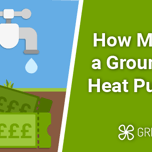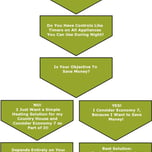
Get up to 4 quotes from our selected suppliers by filling in only 1 form

Save money by comparing quotes and choosing the most competitive offer

Our service is 100% free and with no obligation
- GreenMatch
- Blog
- Low Carbon Heating
Low Carbon Heating Options
7 Low Carbon Heating Systems for Your Home
It is possible to significantly cut back on the amount of CO2 your home emits by opting for low carbon heating options instead of old-fashioned systems like oil- or gas-fuelled boilers.
These systems can provide energy-efficient and sustainable heating while offering the same level of warmth as more carbon-intensive choices.
It can be hard to navigate through the various options of systems available on the market, and to determine which are best for your home, whether it is an electric combi boiler, an air source heat pump, or a solar water heating system. Each type of system has its own advantages, disadvantages, and cost factors to consider.
The UK has been a pioneer on the global scale in terms of Net Zero goal-setting, and low carbon is a key component in the plan. In fact, the Climate Change Committee revealed a new pathway to Net Zero that could mean initial goals are reached 15 years earlier than previously thought.
There are numerous ways to benefit from low carbon heating, and with the increased focus on Net Zero, adopting low carbon in your home is increasingly easier.
Here are seven low carbon heating systems you can use in your home:
- Air Source Heat Pumps
- Ground Source Heat Pumps
- Water Source Heat Pumps
- Electric Combi Boilers
- Biomass Boilers
- Micro-CHP Systems
- Solar Water Heating
1. Heat Pumps
Heat pumps provide low carbon heating and cooling by transferring heat to or from a source outside of your home.
There are several different kinds of heat pumps available, all of which are low carbon heating options for your home. While all work on the same principle, the source of heat makes a significant difference in how each performs, which ultimately also affects the costs.

Air Source Heat Pumps
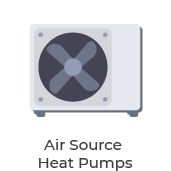
Air source heat pumps work by drawing energy from the outside air. Of the three heat pump systems available, air source options are the cheapest to install and take up the least amount of space.
Air source heat pumps can either be air to air heat pumps, commonly known as air conditioners, or air to water heat pumps. The first only provides space heating, while the latter can provide both space and water heating.
When it comes to prices, air source heat pumps can cost anywhere between £8,000 to £18,000, depending on your property and installer.
Air source heat pumps offer energy-efficient heating in milder climates and have low running costs. However, the colder the area, the less useful these systems become, as the heat pump will need to work harder to warm up the cold air taken from the outside. If you live in an area with exceptionally cold winters, ground and water source heat pumps will be much more suitable.
Ground Source Heat Pumps
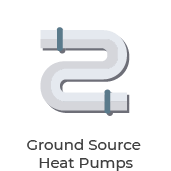
Ground source heat pumps are an energy efficient heating solution as they rely on the temperature of your soil, which is relatively constant year-round. This means the system does not need to work significantly harder in the winter versus in the summer months.
A horizontal ground source heat pump system is installed 1-2 metres below ground, while a vertical system needs to be installed 50-100 metres deep.
When considering costs, ground source heat pump prices do exceed other forms of domestic heating options. Costs can range from £20,000 to £40,000, depending on if it is a horizontal or vertical system. That being said, a ground source heat pump system is also considered the most efficient.
Water Source Heat Pumps
Water source heat pumps extract energy by pumping the fluid from the source directly through the pump. They can be very efficient, but are only practical if you live near a body of water, like a lake or pond.
When it comes to low carbon heating system costs, water source pumps are cheaper than ground source and average around £10,000. They also provide steadier heating, particularly if the body of water is 5-8°C. If your water source freezes during winter, you will probably need a backup heating system.
2. Low-Carbon Boilers and Alternatives
There are many types of boilers on the market, from the more old-fashioned oil fired combi boilers, to gas boilers, to the more modern and low-carbon boiler system: the combi boiler.
There are two primary options you can choose between — electric combi boilers and biomass boilers. It’s also possible to replace your boiler with a micro-CHP system, which uses gas to generate both heat and power at the same time.
Electric Combi Boilers
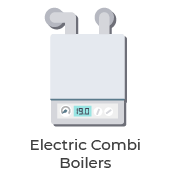
Electric combi boilers use electricity as a fuel to warm your house and provide hot water. Because these boilers don’t require an oil or gas tank, they are very compact, making them an excellent choice for smaller homes with less storage space.
If you are looking for a highly efficient domestic water heating solution, an electric boiler will be a good option. Electric combi boilers don’t need to burn fuel, and therefore lose less energy.
The cost of this type of boiler can vary a lot depending on your property and existing infrastructure, but you could expect anything between £1,000 and £4,500.
Unlike gas and oil burners, the best electric boilers are virtually noiseless due to the lack of fast-moving elements inside. These boilers are also easy to use. Many modern electric combi boilers come outfitted with digital touch screens and controllers that you can remotely manage with home tech like smart thermometers.
These electric boilers are, however, more expensive to run than oil and gas boiler options as they rely on electricity. They also heat water on demand rather than continuously — meaning that they won’t produce as much hot water and may struggle to heat larger homes.
Biomass Boilers

Biomass boilers are powered by burning biomass — typically sustainably-sourced wood pellets. A biomass boiler will be the right choice if you want to replace your current gas or oil boiler with one that performs similarly but doesn’t produce as much carbon.
These boilers will be ideal for larger homes that need a lot of hot water. They are also a good fit for homeowners who want to upgrade their boiler, but don’t want to pay the higher operating costs of an electric combi boiler.
The installation cost of a biomass boiler is £5,000 to £15,000, but then has lower operating costs than other systems, like an electric combi boiler.
Biomass boilers will, however, have all the limitations of a gas or oil boiler. A biomass boiler is going to be about as large as a gas or oil option and will be less energy-efficient than an electric system. In colder months, biomass boilers can also produce a significant amount of noise, or “kettling.”
Micro-CHP Systems
Micro-CHP systems, or micro combined heat and power systems, generate heat and electricity simultaneously using the same energy source. These renewable heating solutions are typically similar to gas boilers in size and shape and are powered by gas mains or liquefied petroleum gas (LPG). While they still rely on fossil fuels, micro-CHP systems are low-carbon because they burn gas to provide both electricity and heat at the same time.
A micro-CHP boiler will cost more than a traditional system to install, but maintenance and servicing costs should be comparable. A micro-CHP boiler probably won’t provide enough electricity to cover your home’s needs. It will, however, reduce the amount of energy that your home will draw from the grid.
3. Solar Water Heating
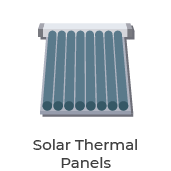
When thinking of solar energy, people oftentimes think of solar panels, which convert sunlight to electricity. But solar energy can also be used for your domestic hot water needs through solar thermal panels.
Solar water heating systems use special solar collectors installed on a house’s roof to gather energy from sunlight, and cost approximately £3,000 to £5,000 to install.
Solar power potentials for the UK are higher towards the south of England, with the most significant possibilities along the southern coasts of England and Wales. The country’s lowest solar potentials are in the Scottish Highlands and Northern Ireland.
While some areas are a better fit for solar power than others, lower solar potential doesn’t rule out the use of these heating systems. It only means that in those regions, they may be slightly less effective. In fact, experts say that devoting just 1% of the UK’s land to solar panels would be enough to generate electricity for all of its needs.
Typically, solar thermal heating systems aren’t able to provide an entire home’s heating — instead, most systems will heat around half of the hot water a home needs, or offer anywhere between 40 and 80 percent of space heating. As a result, you’ll also need to maintain an auxiliary heating system that can provide the rest of the heat — like a boiler or heat pump.
Low-Carbon Heating Grants: The Renewable Heat Incentive
In the UK, the Renewable Heat Incentive (RHI) scheme was a low carbon heating grant that provided seven years of financial support to homeowners who chose to generate heat with renewable sources, like ground source heat pumps, air source heat pumps, biomass boilers, or solar thermal panels. The programme was open for applications until 31 March 2022 and covered England, Wales, and Scotland. There are multiple other government heat pump grants that can help with the costs of installing a heat pump.
Full regulations for the scheme — including who can apply and how much money you can expect to receive — are available at Ofgem’s website. Only renewable heating sources with an MCS certification are covered under the RHI, and the tariff rates vary depending on the low carbon heating system you have.
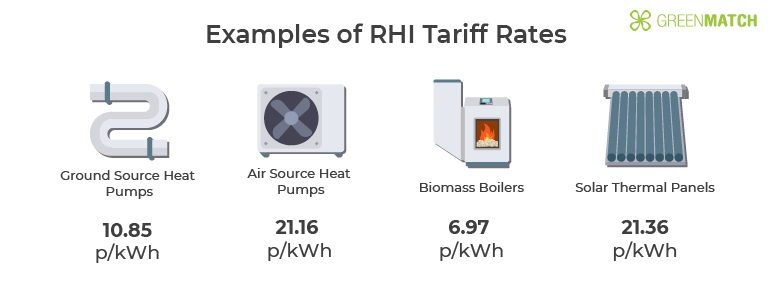
Making use of the RHI can greatly reduce the running cost of the heat pump. For example, if you live in a 2-3 bedroom house in the UK, you can save £2,539 per year through the RHI with a ground source heat pump, and £1,302 with an air source heat pump.
Biomass boilers and solar thermal panels are also eligible, and you can save £836 and £310 annually, respectively.
The Best Options for Low-Carbon Home Heating Systems
Low carbon heating technologies have improved over the last few years, making them more accessible for the everyday homeowner, and are increasingly common as home improvements projects. When making the switch from high carbon to low carbon heating, you have several options: from various heat pump types to boiler types, and even solar energy technologies.
It’s important to consider not only the installation cost of various systems but also efficiency in relation to your local weather conditions and low carbon heating grants.
If you are ready to take the next step and invest in low carbon heating for your home, then fill in the contact form to receive up to four tailored quotes from installers in your area. Our service is non-binding and completely free!
Fill in the form in just 1 minute

Jenna Tsui is a technology and environmental science writer whose work has been published on sites like Get Green Now, Triple Pundit, Renewable Energy Hub and more. To see more posts from Jenna, follow her on Twitter @jenna_tsui
 We strive to connect our customers with the right product and supplier. Would you like to be part of GreenMatch?
We strive to connect our customers with the right product and supplier. Would you like to be part of GreenMatch? - 7 Low Carbon Heating Systems for Your Home
- 1. Heat Pumps
- Air Source Heat Pumps
- Ground Source Heat Pumps
- Water Source Heat Pumps
- 2. Low-Carbon Boilers and Alternatives
- Electric Combi Boilers
- Biomass Boilers
- Micro-CHP Systems
- 3. Solar Water Heating
- Low-Carbon Heating Grants: The Renewable Heat Incentive
- The Best Options for Low-Carbon Home Heating Systems

